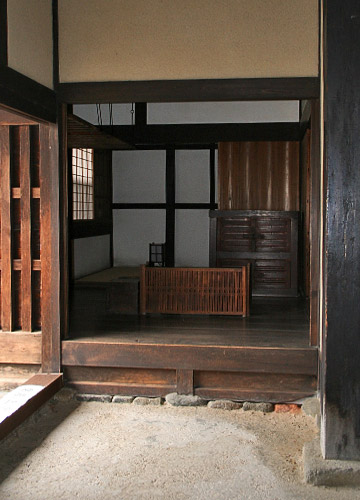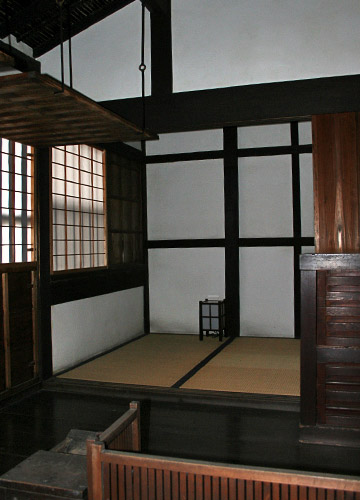|
||
 |
||
1@Abbreviation of *misedana ©¢I.
2@Alternative to *tana I, in the sense of misedana.
3@A room or space at the front of a *machiya ¬Æ, the urban houses of artisans and merchants, adjacent to the entrance and facing onto the street. The room served as a shop where goods for sale were displayed, as a business office, and, on occasion, as part of an artisan's workshop. In the late mediaeval and Edo periods, it generally had a raised floor of timber, sometimes covered with straw mats *tatami ô, but often left uncovered, and in many cases (as in the surviving old machiya of Imaichou ¡ä¬, in Nara) one step lower than the floors of rooms in the living area kyoshitsubu º. In the case of retail shops, it was often made completely openable to the street, using a range of ingenious sliding, upward folding or otherwise removable wooden shutters. See *shitomido ÁË. However, when its functions were primarily those of an office, panels of latticework *koushi iq, were often inserted along the front of the mise as a visual screen. The mise often had a substantial joist-ceilin *neda tenjou ª¾Vä, supporting a low loft or attic *tsushi nikai ~qñK, over it, for the storage of merchandise and the accommodation of staff. This kind of mise developed during the late mediaeval period, but it seems to have had its roots in the late Heian-Kamakura periods misedana. See also *shimomise ºX, *miseoku X.
4@In the indigo dye manufactories aiya ®, of Awa ¢g in Tokushima prefecture during the Edo period, a room used as an office in the fireproof building *dozou y , where the indigo leaves were processed.
5@In the *yuujoya V® of the pleasure districts in the Edo period, a ground-floor room at the front, facing the street, and screened with lattice-work koushi, where the courtesans and female entertainers sat, conspicuous in the brightly illuminated interior, to attract prospective customers.
6@By the Edo period, a general term for business premises, a shop, or a dwelling incorporating a shop.
@
(C)2001 Japanese Architecture and Art Net Users System.@No reproduction or republication without written permission.
fÚÌeLXgEÊ^ECXgÈÇASÄÌRec̳f¡»E]ÚðֶܷB


 @
@